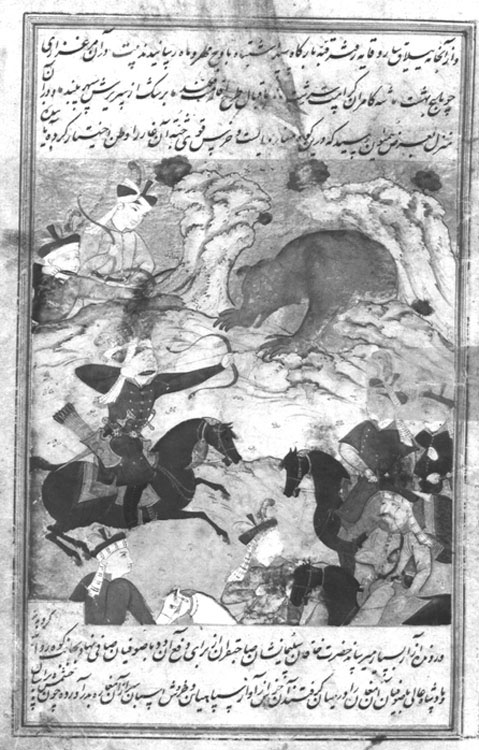Date of this event: 906/1500.
The text relates that when Esmāʿil left his summer quarters at Sārugāya, he came upon a place with a meadow that looked like heaven, where he planned to remain a while. But this was a mistake of great magnitude, for at this location was a mountain with a cave in which lived a very large bear. Since this animal was attacking people and hindering their passage, Esmāʿil resolved to rid the mountain of the menace. Together with a band of his sufis he approached the mountain, occupied the area, and surrounded the cave. Upon hearing the commotion created by the army, the bear stuck its head out of the cave. When the bear saw all these people, it became frightened and attacked in the direction of Esmāʿil. Although only thirteen years of age, Esmāʿil stepped forward, strained his bow and killed the bear. Esmāʿil and his followers remained unmolested in that area for two months before departing in the direction of Arzanjān.
Esmāʿil, astride a frolicking dark colored horse, is visible in the left foreground, his bow drawn taught with an arrow pointed at the oversized bear that can be seen emerging from between two craggy rock formations in the upper right. Two qezelbāš armed with bow and arrow appear from behind the ridge in the upper left. One stands observantly with a bow on his shoulder, but the other is crouched aiming at the bear in case Esmāʿil’s shot misses. Five other qezelbāš , some partially cropped by the frame, are clustered about the lower foreground and lower right corner observing the event. All are mounted and wear the distinctive qezelbāš tāj with kolāh.
Painting: 13.4 x 12.2 cm. Three lines of text above, and two lines below the painting. Frame encloses painting and text. Painting damaged in several places: a large dark smear extends on a slight diagonal from the upper margin to the bear; a smaller smear is just above Esmāʿil’s head; and a third adjoining the frame on the left side just next to the archer. What seems to have been, or still is, a tape mark appears as a darker rectangular area on the right side about midway down the page. The features on two of the faces - Esmāʿil’s and the qezelbāš in the center foreground - have been obliterated by abrasion. No apparent signs of retouching. The painting is signed in the lower margin in miniscule characters in Moʿin’s hand: raqam zad kamina moʿin-e moṣavver. Not dated.
Painting references:
Unpublished.
Robert Eng
Last updated: November 16, 2010
